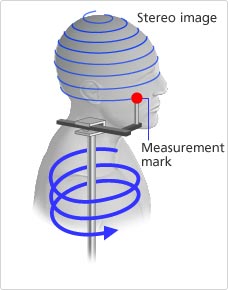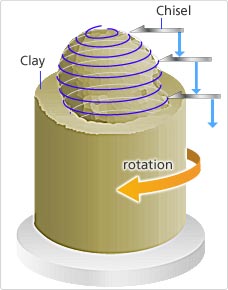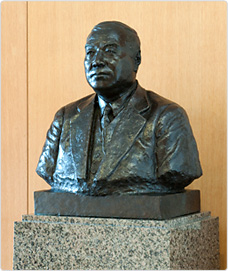
A bronze statue of the sumo wrestler, Futabayama, made using stereo photo-sculpture equipment.
Between 1936 and 1946, Nikon (formerly Nippon Kogaku K.K.) was engaged in the production of bronze statues of people.
The manufacture of a bronze statue involves copying the form of the model, typically a person. The sculptor will normally make a clay prototype for the bronze based on the actual model or photographs of the model. A mold is then constructed from this prototype and the statue is cast.
It is impossible to produce a satisfactory bronze statue if the shape of the prototype is not faithfully reproduced. Manufacturing the prototype requires a high degree of skill.
What is stereo photography?

A stereo photo-sculpture catalogue
Picture: Senzoku Shoji
Stereo photography, as referred to in the title, involves the use of photographs to create a stereoscopic view.
On average, a person's eyes are approximately 65 mm apart. Because of this spacing, the left and right eyes perceive images from a slightly different angle. This is known as "parallax." The human brain makes use of this parallax for depth perception, which enables a stereoscopic view to be perceived. Stereo photography makes use of this mechanism to create a stereoscopic view by showing the left and right eyes two different photographs (which are shot in such a way as to cause parallax).
The device used to shoot parallax photographs is known as a "stereo camera." A stereo camera consists of two cameras that are spaced horizontally and configured to shoot photographs simultaneously.
Stereo photo-sculpture equipment
Stereo photo-sculpture equipment (hereafter, "sculpture equipment") was developed for creating stereo photo-sculptures. The sculpture equipment was designed to create prototypes for bronze statues and thus included a stereo camera for taking stereo photographs, a binocular-vision imaging mechanism for producing a stereoscopic view from the photographs that have been shot, and a carving mechanism for paring down the clay.
The stereo camera shoots a model at an object distance of 1 meter. Two mirrors are located behind the model, with the set-up enabling photographs to be taken simultaneously from three directions—from the front, the left, and the right.
The model is shot as a negative image, which is then converted to a positive image during the development process. The camera described here is not a single-lens reflex camera but a view camera, which uses photographic plates. The camera is reloaded with two positives images. The binocular-vision imaging mechanism is then attached to the camera and if the two positive images are viewed with both eyes, a stereo image becomes visible 1 meter away. The model appears upside-down and reversed left-to-right on the photographic plate; however, the prisms in the binocular-vision imaging mechanism restore the image to a normal upright image. The binocular-vision imaging mechanism also enlarges the image and displays it in stereo, enabling the details of the model to be checked.
A measurement mark is placed at the position at which the stereo image is rendered. The measurement mark appears on the focal plane, as seen through the photographic lens. Since the photographic plates are transparent, the measurement mark appears superimposed on the stereo image.

A prototype being produced by the stereo photo-sculpture equipment
Picture: Senzoku Shoji

(The two negatives taken are shown below the main diagram.)
Producing a prototype using a three-dimensional tracing picture method
When the sculpture equipment is operated, a motor rotates the measurement mark. The clay wheel is coupled to the measurement mark so that the rotation of the wheel is synchronized to the rotation of the mark.
As the measurement mark rotates, it gradually descends. The connected chisel also descends in line with the measurement mark. As the operator rotates the handle, the measurement mark's radius of rotation varies, and this movement is connected to the chisel movement. The chisel retracts as the mark's radius of rotation increases and extends as the radius decreases.
When operating the sculpture equipment, the operator first aligns the top of the stereo image with the measurement mark. The measurement mark then starts to descend and rotate. The operator uses an operating handle to vary the radius of the mark's rotation, so as to align the mark with the contours of the stereo image.
The measurement mark moves in a spiral, describing the shape of the stereo image. This path automatically adjusts the movements of the chisel and the rotation of the clay wheel, resulting in the clay being pared down to the shape of the stereo image. An accurate prototype is produced, as if it had been traced in stereo.
A mechanism connecting the measurement mark and chisel also enables half-size bronzes to be produced.
The person commissioning the bronze statue would then check the clay prototype that had been produced in this fashion. Once it had met with their satisfaction, a plaster cast based on the prototype would be made and a mold created. Bronze would then be poured into the mold and, following the casting, the finishing touches would be applied, completing the production of the bronze statue.

Stereo image and movement of the measurement mark.

Movement of the clay and chisel
Works of art created using machinery
The creation of stereo photo-sculpture was an idea dreamed up by engineers conducting research on three-dimensional measurement using range-finders. Research and development of sculpture equipment commenced in November 1931. Then, in May 1935, the company obtained patents in Japan, the United States, Great Britain, Germany, France and Italy, as well as other countries.
In 1937, bronze statues of the sumo wrestlers Tamanishiki and Futabayama, both yokozuna, created using stereo photo-sculpture were displayed at the Pan-Pacific Peace Exposition in Nagoya. This provided the impetus for the company to start production of bronze statues.
In terms of its low cost, quick turnaround, and ability to faithfully reproduce a model, stereo photo-sculpture was a revolutionary technology. In addition to the fact that this was an era in Japan in which the building of statues conferred status, the process was also well received as being the "creation of works of art using machinery." In the wake of this response, Nikon established specialist stereo photo-sculpture studios in the Marunouchi Building in Tokyo and the Nankai Takashimaya department store in Osaka (now known as the Takashimaya Osaka Store). Bronze statues were produced using sculpture equipment at the Ohi Plant in Tokyo, based on the stereo photographs shot at these studios.
Existing bronze statues created using stereo photo-sculpture
From 1939, military demand took priority and regulations restricting the use of copper were enacted, dealing a major blow to the business of sculpture involving the use of copper as a raw material. The following year, the company reacted by substituting hard plaster, ceramics and cement as the main raw materials, and between 1940 and 1944, the company succeeded in manufacturing 710 statues.
Surviving records indicate that statues were manufactured of successive presidents of Nippon Kogaku K.K., including Yoshihira Wada, the first president of the company. However, no bronze produced using stereo sculpture has survived at Nikon. Since copper was of great value during the war, it is highly likely that the bronzes were melted down and the material used for other purposes.
One existing bronze statue produced using stereo photo-sculpture that remains available for public viewing is the statue of Koyata Iwasaki, found in the lobby of the Seikado Bunko Art Museum. Koyata Iwasaki was the fourth president of Mitsubishi-sha, Ltd. and was closely involved in the establishment of Nippon Kogaku K.K..
After the war, demand for statues plummeted, and the company produced very few. The manufacture of bronzes ceased in 1946. Subsequently, former Nikon employees established a bronze statue production division at a company called the Senzoku Chemical Research Institute (which is now known as Senzoku Shoji). People who had worked in stereo photo-sculpture joined this division and in 1958 stereo photo-sculpture recommenced. This company made various improvements to stereo photo-sculpture and is still producing bronze statues to this day.

Statue of Koyata Iwasaki(Seikado Bunko Art Museum)

The Nippon Kogaku K.K. logo and month and year of manufacture, February 1935, can be found engraved in the back of the statue.
3D technology—dating back more than 70 years
In recent years, 3D technology in cinema and television has attracted attention. This technology works on the same principle as stereo photo-sculpture, in that it makes use of parallax between the two eyes.
With current 3D technology, the focus is on showing 2D images in stereo. Meanwhile, for the past 70-odd years, there have been engineers with innovative ideas for creating stereoscopic views as well as advanced technology for making these ideas a reality. This technology still lives on today.



